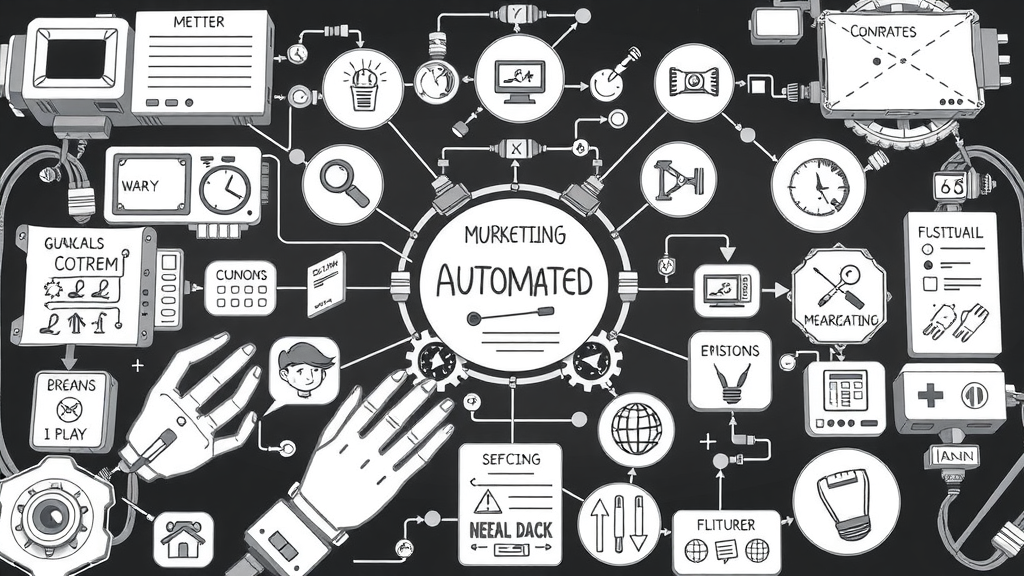
- Discover the potential of content automation in transforming business processes.
- Learn how marketers today leverage automation for enhanced productivity.
Understanding What Is Content Automation
Content automation is more than just a buzzword in digital marketing; it's a powerful tool that can streamline and optimize your content process. By leveraging digital tools, content automation works to efficiently manage tasks from content creation to distribution, reducing manual effort and time consumption. But what is content automation exactly, and how does it differ from marketing automation?
While both aim to streamline processes, content automation specifically focuses on the production, management, and distribution of content. In contrast, marketing automation encompasses a broader scope, including customer journey workflows, email marketing, and social media engagement strategies. It's important to understand these differences to harness the full potential of content automation in your marketing strategy.

The Role of Content Automation in the Content Creation Process
Incorporating content automation in your content creation process can streamline your workflow immensely. From idea generation to publishing, automation tools enhance each step by eliminating repetitive tasks and minimizing errors. By adopting these tools, teams can focus more on crafting engaging narratives rather than getting bogged down by mundane tasks.
Automation plays a key role in elevating productivity and ensuring quality control. For instance, AI tools can assist in keyword research, content optimization, and even in automating proofreading processes, saving valuable time and enhancing the quality of the output content.
Automating Content Creation vs. Traditional Methods
Content automation versus traditional content strategies present a compelling contrast. Automating content creation offers significant advantages in speed and consistency over manual methods while allowing marketers to focus on strategic decision-making. However, it is crucial to navigate potential pitfalls such as compromising creativity and authenticity.
The most effective digital strategies strike a harmonious balance, leveraging the speed and consistency of automation while preserving the unique human touch. Understanding the pros and cons is essential for implementing automation tools without losing the essence of your brand's voice.

Content Automation Tools: What Marketers Need to Know
Having a deep understanding of available content automation tools is essential for marketers who want to elevate their content strategies. Tools like HubSpot, Buffer, and Hootsuite help manage different segments of content marketing, offering features tailored to automation needs.
Choosing the right platform involves comparing the features, scalability, and ease of integration with existing systems. It's crucial to align the capabilities of a tool with the specific needs of your marketing team to facilitate seamless adoption and maximize efficiency.

Benefits of Content Automation for Modern Marketers
“Marketers today benefit significantly from automation in brand consistency and performance tracking.”
Content automation offers numerous advantages, including enhancing **efficiency** and **productivity**. It accelerates production timelines, minimizes errors, and allows marketing teams to refocus resources on strategic planning and innovation, hence boosting overall productivity.
Getting Started with Content Automation
If you're considering implementing content automation, start by defining clear goals. Consider what aspects of your content creation and distribution can be **automated**. Begin small, implementing changes incrementally to ease the transition for your team.
Challenges such as selecting suitable tools, training staff, and ensuring smooth integration within your existing digital ecosystem are common. A strategic approach, emphasizing careful planning and flexibility, is key to overcoming these hurdles.
| Tool | Features | Pros | Cons |
|---|---|---|---|
| HubSpot | SEO Optimizer, Social Media Management | User-friendly interface | Costly subscription |
| Hootsuite | Social Media Scheduling | Comprehensive analytics | Steep learning curve |

Future of Content Automation
The horizon for content automation looks promising, driven by advancements in AI and machine learning. These technologies are poised to further revolutionize how content marketing strategies are executed, creating **automated** systems capable of real-time data analysis and adaptive content strategies.
“The future of content automation is transformative, with AI revolutionizing content marketing strategies.”
Expect AI tools to enhance personalization efforts, automation of **bulk email campaigns**, and **social media** interactions, creating more meaningful customer engagements.

Areas for Automation in Content Marketing
Identifying which content marketing components can be automated effectively is crucial. Marketing teams can leverage automation for tasks like scheduling posts, **content curation**, and performance analytics, enhancing reach and engagement.
Additionally, automation can bolster other aspects of your **marketing strategies**, enabling content teams to efficiently implement and expand their plans across various platforms, thereby improving overall brand presence.
Maximizing the Impact of Automated Content
Automated content can significantly enhance the user experience by ensuring timely and relevant interactions. Emphasizing **brand consistency** through automated messaging can solidify customer trust and loyalty.
Moreover, automatic personalization features can make engagements feel bespoke, increasing customer satisfaction and fostering deeper connections.

People Also Ask: Unpacking Common Questions
What is an example of content automation?
Content automation can be exemplified by using a social media scheduling tool like Buffer. It automates posting, ensuring your content reaches the audience at optimal times without manual intervention.
What is automation content?
Automation content refers to the text, images, and media generated or managed by automation tools, meant for consistent and strategic distribution across channels.
How does content automation work?
Content automation works by utilizing software to streamline **workflows**. From content ideation to publication, automation software handles repetitive tasks, freeing up human resources for creative and strategic efforts.
What are the four types of automation?
The four main types of automation include Fixed, Programmable, Flexible, and Intelligent Automation, each offering varying levels of complexity and adaptability to industry needs.

Conclusion: Content Automation for Productivity and Efficiency
Adopting content automation can enhance efficiency and offer future-oriented benefits, leading marketers to competitive advancement in the digital landscape.
 Add Row
Add Row  Add
Add 




Write A Comment